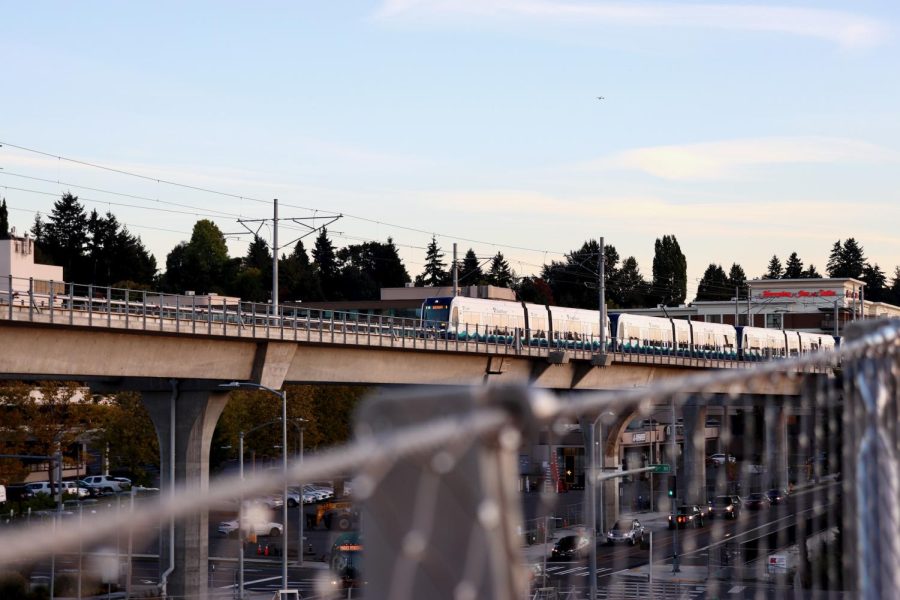Northgate Link Extension Provides New Opportunities for Seattle U Students
Sound Transit Link light rail train approaching Northgate Station.
Affordable public transportation options make it more accessible to explore Seattle, and are expanding with the opening of the Link light rail Northgate Link Extension. The three additional stops in the University District, Roosevelt and Northgate opened on Oct. 2 across 4.3 miles. The extension will provide service every eight minutes during peak hours and it is expected to have over 40,000 daily users by 2022.
The ballot initiative to build the Northgate Link Extension called Sound Transit 2 (ST2) passed in 2008 with construction starting in 2012. ST2 passed with the intention of eventually creating a larger mass transportation system and the extension was one of many projects passed. The Link light rail will expand through other Link extensions from 22 miles to 62 miles over the next three years.
John Gallagher, a public information officer at Sound Transit, explained the projects that will be progressing in upcoming years.
“[ST2] was meant to develop a comprehensive and integrated regional transit system. What we’re going to be seeing over the next couple of years is extending service east to Bellevue and Overlake in 2023, in 2024 over to Downtown Redmond, up to Lynnwood and down to Federal Way. That’s really building out the spine of the system,” Gallagher said.
The introduction of the 2008 ST2 document emphasized a need to cut down on traffic, saying that by 2030, there could be a 30% increase in vehicle travel if not for ST2.
Craig Birklid, the executive director of Public Safety and Transportation at Seattle U, emphasized that the link extension could help commuter students avoid that traffic.
“I think it’s going to give them an opportunity to get right to Capitol Hill in a very direct and fast way. We all know that buses get caught up in the regular traffic, so they can be delayed,” Birklid said. “We’ve waited for so many years to have a light rail system that works for the region, and it kind of feels like it’s starting to happen. I think it’s awesome.”
An ORCA card is one way for students to utilize the three new stops. Students can no longer rent complimentary ORCA cards from the Hub desk in the Student Center. There are two kinds of ORCA cards Seattle U students can get, both of which are subsidized 50% by the university.
The ORCA Lift card offers a reduced fare for people whose household income is below 200% of the federal poverty level. For a family size of one, that’s $2,147 per month. Seattle U also offers a non-lift ORCA card, which does not have a reduced fare but is still subsidized by 50%.
While it can be an inconvenience to get a Seattle U-associated ORCA card, Birklid explained that it becomes easier after getting the card the first time since it can be reloaded through the permit store remotely.
“There’s that one inconvenience of getting your Seattle U ORCA card, but once you have it you can continue to reload it remotely which I think is a great asset for folks not to have to come jumping over to Public Safety to stand in line and do that,” Birklid said.
For students who are not looking for a long-term purchasing commitment, there is an app called Transit Go where one-time passes can be purchased from a phone.
One barrier for students using public transportation is how vast and complex the public transportation system in Seattle is. This was the case for Alyssa Garcia, a second-year pre major student who uses the Link light rail about once a week.
“At first it was a little challenging because I didn’t know how exactly it worked. I’m from LA and everybody drives and we’re all stuck in traffic,” Garcia said. “Coming to a new city where not everybody has a car, and everyone relies on buses, the streetcars, the light rail, or even their scooters and their bikes was really crazy for me to see.”
To help combat those challenges, Birklid shared a website to help plan trips he found helpful.
“The metro site is ok, but if you go to the metro site they have a trip planner, they also have routes so you can see what routes go where.” Birklid said. “The Sound Transit, if you go to that website, it incorporates metros as well. It’s a really good website.”
Seattle’s public transit will only become more complex in the future, providing more opportunities for students to explore Seattle. While waiting for the new transit systems, students can take their time exploring the three new light rail stops.


